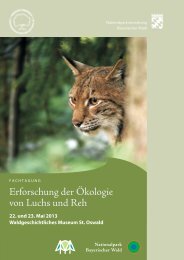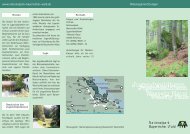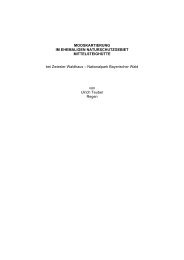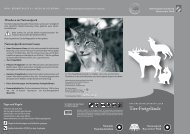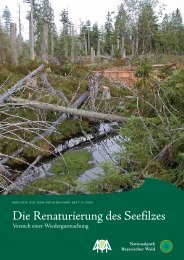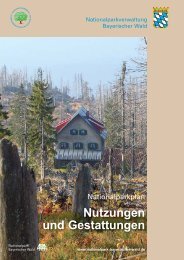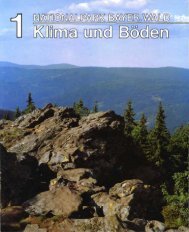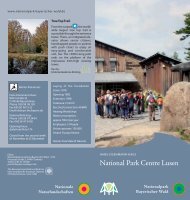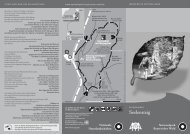The regional economic impact of Bavarian Forest National Park
The regional economic impact of Bavarian Forest National Park
The regional economic impact of Bavarian Forest National Park
You also want an ePaper? Increase the reach of your titles
YUMPU automatically turns print PDFs into web optimized ePapers that Google loves.
• <strong>The</strong> interviews in which tourists were asked about their<br />
perception <strong>of</strong> the dead wood areas in the national park<br />
were structured to allow as much comparison as possible<br />
with existing studies (Suda/Pauli 1998; Suda/Feicht<br />
Map 1: Survey area <strong>Bavarian</strong> <strong>Forest</strong> and tourism intensity <strong>of</strong> its communities<br />
3. Visitor numbers<br />
<strong>The</strong> survey area includes the counties <strong>of</strong> Freyung-Grafenau<br />
and Regen. Map 1 illustrates the area and its tourism intensity<br />
on a community level. Figure 1 shows the development<br />
<strong>of</strong> overnight stays in the region since the 1980s, compared to<br />
its development in the whole <strong>of</strong> Bavaria and to the booming<br />
branch <strong>of</strong> city tourism.<br />
With a total <strong>of</strong> 760,000 visitors in 2007, the national park is<br />
the most visited attraction in the region and receives almost<br />
three times as many visitors as the Mt Arber ski resort (Harrer<br />
2004). A previous study (Kleinhenz 1982: 52ff.) estimates<br />
that in 1981 between 1.3 and 1.4 million people visited<br />
the national park.<br />
In this study at the beginning <strong>of</strong> the 1980s, however, no systematic<br />
year-round and area-wide visitor counts were carried<br />
out; the quoted figures were based on the estimations <strong>of</strong> the<br />
national park administration. It is therefore impossible to<br />
compare the present study with its predecessor. Thus it<br />
would be wrong to conclude that the interest <strong>of</strong> tourists in<br />
2002). <strong>The</strong> survey took place on weekends and weekdays<br />
in the summer <strong>of</strong> 2007 using a standardised questionnaire.<br />
<strong>The</strong> sample comprises a total <strong>of</strong> 608 respondents.<br />
<strong>Bavarian</strong> <strong>Forest</strong> <strong>National</strong> <strong>Park</strong> has declined over the years.<br />
Visitor counts from the visitor centres Hans-Eisenmann-<br />
Haus and Haus zur Wildnis (opened recently in 2006), provide<br />
a more reliable comparison: In 1982 211,000 people visited<br />
the Hans-Eisenmann-Haus and in 2007 around<br />
255,000 visitors came to both visitor centres.<br />
According to our survey from 2007 visitors are mainly concentrated<br />
around the primary tourist attractions (visitor centres<br />
and their wildlife parks) whereas the rest <strong>of</strong> the visitors<br />
is distributed widely across the whole protected area. Given<br />
this concentration on the visitor centres and the visitor<br />
numbers <strong>of</strong> the latter reported above, a visitor number <strong>of</strong><br />
more than one million, either now or then, does not seem<br />
very realistic.<br />
6



